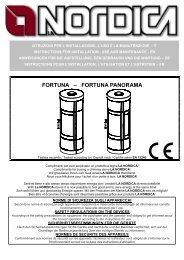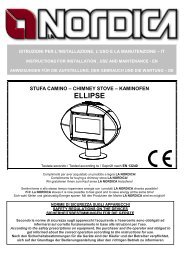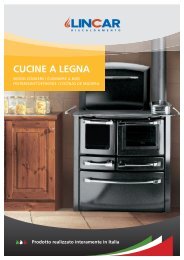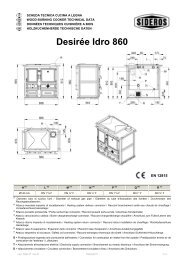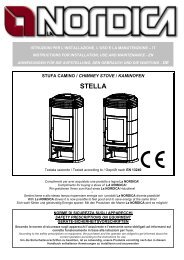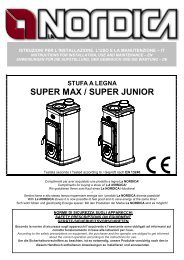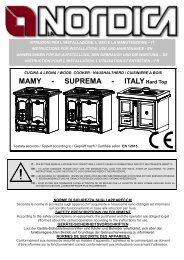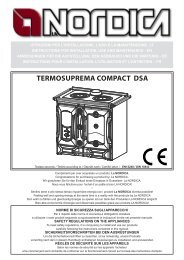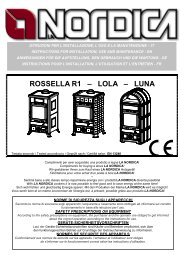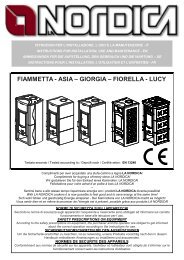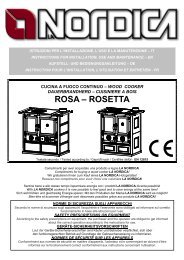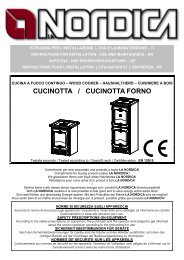MONOBLOCCO 400 PIANO - 500 ANGOLO – 800 ANGOLO / Dx - Sx
MONOBLOCCO 400 PIANO - 500 ANGOLO – 800 ANGOLO / Dx - Sx
MONOBLOCCO 400 PIANO - 500 ANGOLO – 800 ANGOLO / Dx - Sx
You also want an ePaper? Increase the reach of your titles
YUMPU automatically turns print PDFs into web optimized ePapers that Google loves.
Monoblocco <strong>400</strong> Piano <strong>–</strong> <strong>500</strong> / <strong>800</strong> Angolo<br />
paper ball passed in the ash to rub it. Do not use cloths, abrasive or chemically aggressive products by<br />
cleaning the hearth glass.<br />
The correct lighting phase, the use of proper quantities and types<br />
of fuels, the correct position of the secondary air regulator,<br />
enough draught of the chimney-flue and the presence of<br />
combustion air are the essential elements for the optimal<br />
functioning of the appliance and for the cleaning of the glass.<br />
BREAKING THE GLASS DOORS: The glass doors are made<br />
in glass ceramic resistant to heat up to 750°C and are<br />
therefore not prone to thermal shocks. They can only be<br />
broken in the instance of mechanical shocks (bumps or<br />
slamming of the door, etc.). They are therefore not replaced<br />
under the terms of the warranty.<br />
13.3. CLEANING THE ASH DRAWER<br />
All the devices feature a hearth grate and ash drawer for collecting ash.<br />
You should empty the ash drawer regularly to avoid it filling up completely and therefore prevent the grate from<br />
overheating. We also recommend you always leave 3-4 cm of ash in the hearth.<br />
Ash removed from the hearth should be placed in a fire-resistant container with air-tight cover. The container should<br />
be placed on a fire-resistant floor away from flammable materials until they are fully extinguished and cooled down.<br />
Check and clean the external air intake at least one a year.<br />
The chimney sweeper should sweep out the stack on a regular basis.<br />
Ask your local chimney sweeper to check that the device is properly installed, connected to the stack and ventilated.<br />
13.4. MAINTENANCE OF THE EXTENDABLE GUIDES<br />
The fireplace’s door is attached to extendable ball guides to ensure silent, reliable and durable operation. The<br />
lubricant on the guides, however, wears off the more the device is used, making the door less easy and noisier to<br />
slide open. A syringe of heat-resistant lubricant is therefore provided with each fireplace for the user to lubricate the<br />
guides whenever necessary (if the door opens noisily or with less ease).<br />
You need to fully raise the door and use the syringe to apply two doses of lubricant (0.5 ml each, as indicated on the<br />
syringe’s graded scale) at the highest visible point on a rail. Do not exceed the recommended quantity.<br />
Repeat the same procedure on the other rail and raise and lower the door a couple of times to spread the lubricant<br />
over all the ball guides.<br />
ATTENTION: use only syringe lubricant supplied by La Nordica.<br />
You should only use spare parts approved and supplied by La Nordica. Please contact your specialized retailer if you<br />
require spare parts. You must not make any changes to the device!!!<br />
14. SUMMER HOLIDAYS<br />
You need to clean the hearth, stack and flue, removing all ash and any other residue and then close all of the hearth’s<br />
doors and regulators.<br />
The flue should be cleaned at least once a year; in the meantime, check the condition of the door seals which, if not in<br />
perfect condition (no longer adhering to the door), will not guarantee the device’s perfect working order! Any worn<br />
seals should therefore be replaced.<br />
Place absorbent salts in the hearth if there is any humidity in the room where the device is installed.<br />
You can rub the internal cast iron components in neutral Vaseline to keep them looking good.<br />
15. DETERMINING THERMAL POWER<br />
There are no hard and fast rules on how to calculate the correct thermal power required. Thermal power depends on<br />
the space to be heated and also largely on insulation. The average thermal output required for a reasonably well<br />
insulated room is 40kCal/h per m³ (with outside temperature at 0°C).<br />
As 1kW corresponds to 860kCal/h, we can calculate a value of 50W/m³.<br />
Picture 21<br />
If you wish to heat a room of 150 m³ (10 x 6 x 2.5 m) in an insulated house, you will require 150m 3 x 50W/m 3 = 7<strong>500</strong>W<br />
or 7.5kW. A 10kW device will therefore be sufficient for heating .<br />
28 6098401 Rev.09 <strong>–</strong> EN<br />
A



